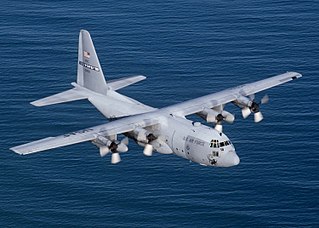
The Lockheed C-130 Hercules is an American four-engine turboprop military transport aircraft designed and built by Lockheed. Capable of using unprepared runways for takeoffs and landings, the C-130 was originally designed as a troop, medevac, and cargo transport aircraft. The versatile airframe has found uses in other roles, including as a gunship (AC-130), for airborne assault, search and rescue, scientific research support, weather reconnaissance, aerial refueling, maritime patrol, and aerial firefighting. It is now the main tactical airlifter for many military forces worldwide. More than 40 variants of the Hercules, including civilian versions marketed as the Lockheed L-100, operate in more than 60 nations.

The Douglas DC-8 is an early long-range narrow-body jetliner designed and produced by the American Douglas Aircraft Company. Work began in 1952 towards the United States Air Force's (USAF) requirement for a jet-powered aerial refueling tanker. After losing the USAF's tanker competition to the rival Boeing KC-135 Stratotanker in May 1954, Douglas announced in June 1955 its derived jetliner project marketed to civil operators. In October 1955, Pan Am made the first order along with the competing Boeing 707, and many other airlines soon followed. The first DC-8 was rolled out in Long Beach Airport on April 9, 1958, and flew for the first time on May 30. Following Federal Aviation Administration (FAA) certification in August 1959, the DC-8 entered service with Delta Air Lines on September 18.

The Douglas C-124 Globemaster II, nicknamed "Old Shaky", is an American heavy-lift cargo aircraft built by the Douglas Aircraft Company in Long Beach, California.

The Douglas C-133 Cargomaster is an American large turboprop cargo aircraft built between 1956 and 1961 by the Douglas Aircraft Company for use with the United States Air Force. The C-133 was the USAF's only production turboprop-powered strategic airlifter, entering service shortly after the Lockheed C-130 Hercules, which is designated a tactical airlifter. It provided airlift services in a wide range of applications, being replaced by the C-5 Galaxy in the early 1970s.

The Rolls-Royce AE 2100 is a turboprop developed by Allison Engine Company, now part of Rolls-Royce North America. The engine was originally known as the GMA 2100, when Allison was a division of former corporate parent General Motors.

The Boeing C-97 Stratofreighter was a long-range heavy military cargo aircraft developed from the B-29 and B-50 bombers. Design work began in 1942, the first of three prototype XC-97s flew on 9 November 1944 and the first of six service-test YC-97s flew on 11 March 1947. All nine were based on the 24ST alloy structure and Wright R-3350 engines of the B-29, but with a larger-diameter fuselage upper lobe and they had the B-29 vertical tail with the gunner's position blanked off. The first of three heavily revised YC-97A incorporating the re-engineered wing, taller vertical tail and larger Pratt & Whitney R-4360 engines of the B-50 bomber, flew on 28 January 1948 and was the basis of the subsequent sole YC-97B, all production C-97s, KC-97s and civilian Stratocruiser aircraft. Between 1944 and 1958, 888 C-97s in several versions were built, 811 being KC-97 tankers. C-97s served in the Berlin Airlift, the Korean War, and the Vietnam War. Some aircraft served as flying command posts for the Strategic Air Command, while others were modified for use in Aerospace Rescue and Recovery Squadrons (ARRS).

The Boeing C-135 Stratolifter is a transport aircraft derived from the prototype Boeing 367-80 jet airliner in the early 1950s. It has a narrower fuselage and is shorter than the 707. Boeing gave the aircraft the internal designation of Model 717. Since the first one was built in August 1956, the C-135 and its variants have been a fixture of the United States Air Force.
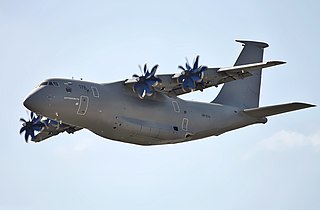
The Antonov An-70 is a four-engine medium-range transport aircraft, and the first aircraft to take flight powered only by propfan engines. It was developed in the late 1980s by the Antonov Design Bureau to replace the obsolete An-12 military transport aircraft. The maiden flight of the first prototype took place in December 1994 in Kyiv, now independent Ukraine. Within months the prototype had suffered a mid-air collision. A second airframe was produced to allow the flight-test programme to proceed. Both prototypes were produced by the Kyiv Aircraft Production Plant.

The Pratt & Whitney Canada PW100 aircraft engine family is a series of 1,800 to 5,000 shaft horsepower turboprops manufactured by Pratt & Whitney Canada. Pratt & Whitney Canada dominates the turboprops market with 89% of the turboprop regional airliner installed base in 2016, leading GE Aviation and Allison Engine Company.

The McDonnell Douglas MD-94X was a planned propfan-powered airliner, intended to begin production in 1994. Announced in January 1986, the aircraft was to seat between 160 and 180 passengers, possibly using a twin-aisle configuration. An all-new design that was investigated internally since at least 1984, the MD-94X was developed in the mid-1980s to compete with the similar Boeing 7J7. The price of oil would have to be at least US$1.40 per gallon for McDonnell Douglas to build the plane, though. Configuration was similar to the MD-80, but advanced technologies such as canard noseplanes, laminar and turbulent boundary layer control, side-stick flight control, and aluminum-lithium alloy construction were under consideration. Airline interest in the brand-new propfan technology was weak despite claims of up to a 60% reduction in fuel use, and both aircraft were canceled.
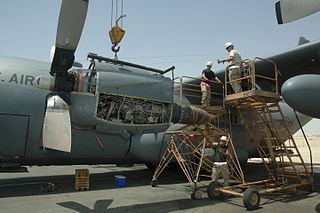
The Allison T56 is an American single-shaft, modular design military turboprop with a 14-stage axial flow compressor driven by a four-stage turbine. It was originally developed by the Allison Engine Company for the Lockheed C-130 Hercules transport entering production in 1954. It has been a Rolls-Royce product since 1995 when Allison was acquired by Rolls-Royce. The commercial version is designated 501-D. Over 18,000 engines have been produced since 1954, logging over 200 million flying hours.

The General Electric GE36 was an experimental aircraft engine, a hybrid between a turbofan and a turboprop, known as an unducted fan (UDF) or propfan. The GE36 was developed by General Electric Aircraft Engines, with its CFM International equal partner Snecma taking a 35 percent share of development. Development was cancelled in 1989.

The Honeywell T55 is a turboshaft engine used on American helicopters and fixed-wing aircraft since the 1950s, and in unlimited hydroplanes since the 1980s. As of 2021, more than 6,000 of these engines have been built. It is produced by Honeywell Aerospace, a division of Honeywell based in Scottsdale, Arizona, and was originally designed by the Turbine Engine Division of Lycoming Engines in Stratford, Connecticut, as a scaled-up version of the smaller Lycoming T53. The T55 serves as the engine on several major applications including the CH-47-Chinook, the Bell 309, and the Piper PA-48 Enforcer. The T55 also serves as the core of the Lycoming ALF 502 turbofan. Since the T55 was first developed, progressive increases in airflow, overall pressure ratio, and turbine inlet temperature have more than tripled the power output of the engine.
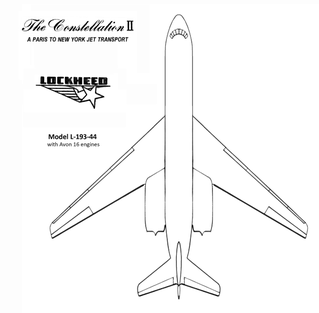
The Lockheed L-193 Constellation II was a jet airliner design concept, designed between 1949 and 1953 with a swept wing and engines mounted at the tail. An airliner and tanker version were developed. The latter, in an aerial refueling competition initiated by the United States Air Force (USAF), won and was preferred over the Boeing KC-135 Stratotanker. Since the competing Boeing aircraft was ready to fly first, examples were ordered as an interim measure. They performed well enough that the L-193 was never ordered as a tanker, and airliner plans were dropped soon after.
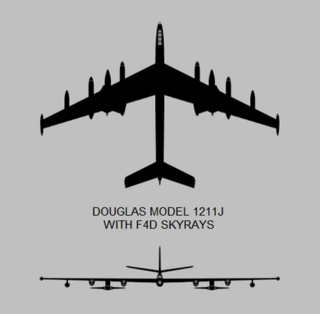
The Douglas 1211-J was a bomber aircraft design developed by American aircraft manufacturer Douglas to compete with the Boeing B-52 design for a major United States Air Force contract between 1946 and 1954. The Model 1211-J design was 160 feet long with a wingspan of 227 feet, and was powered by four turboprop engines. The aircraft was designed around a new 43,000-pound conventional bomb but could carry nuclear weapons as well. It could also carry its own fighter escorts, as parasites under its wings. These fighters' jet engines were to be powered up to assist the carrier bomber during takeoff; refueling of the fighters was to take place while they were stowed on the mothership's underwing pylons.

The Progress D-236 was an experimental aircraft engine, a hybrid between a turbofan and a turboprop known as a propfan. Also known as the Lotarev D-236T, the three-shaft geared engine was designed in the 1980s and 1990s to power proposed propfan aircraft such as the Tupolev Tu-334, Ilyushin Il-118, and Ilyushin Il-88.

The Pratt & Whitney XT57 was an axial-flow turboprop engine developed by Pratt & Whitney in the mid-1950s. The XT57 was developed from the Pratt & Whitney J57 turbojet.
The Allison T61 was a 6,500-shaft-horsepower (4,800-kilowatt) turboprop engine that was to power the 1959 version of the proposed Lockheed Super Hercules military and civil freight aircraft. The U.S. Air Force (USAF) had helped Allison fund the development of the T61 for four years. Lockheed had received orders from Pan American World Airways and Slick Airways for a total of 18 aircraft, but both orders were contingent on the military ordering the aircraft by September 30, 1959, around the date that the USAF's engine development contract expired. The development contract was extended temporarily to November 30, 1959, but the T61 development effort was canceled by January 1960, after USD$37.5 million had been put into the engine's development. Four T61 engines had run on the test stand at the time of cancellation.

The Allison T56 turboprop engine has been developed extensively throughout its production run, the many variants are described by the manufacturer as belonging to four main series groups.
The Allison T78 was a turboprop engine that first ran in March 1965. It used a regenerator that recovered and reused exhaust heat to reduce fuel consumption.


















